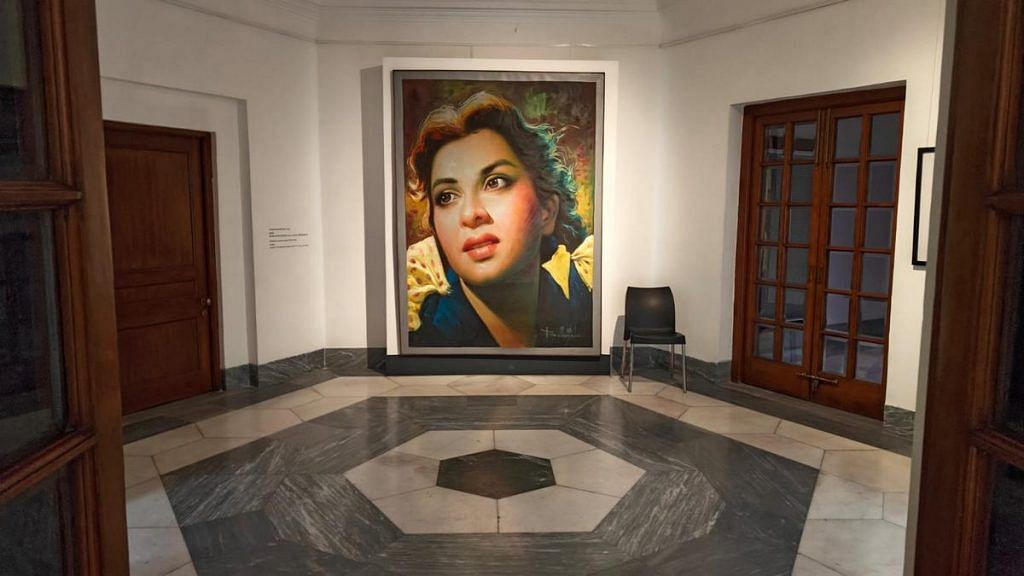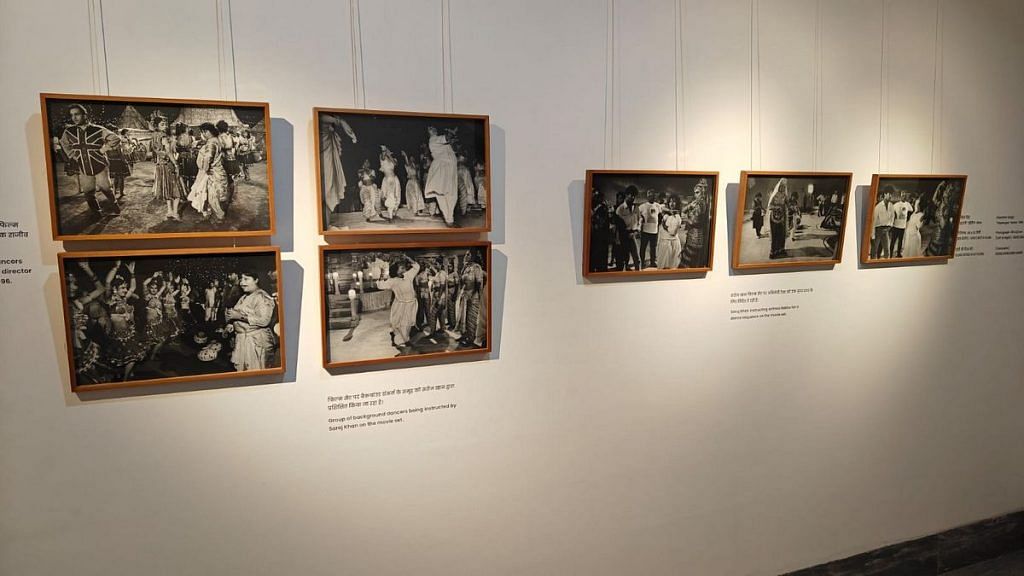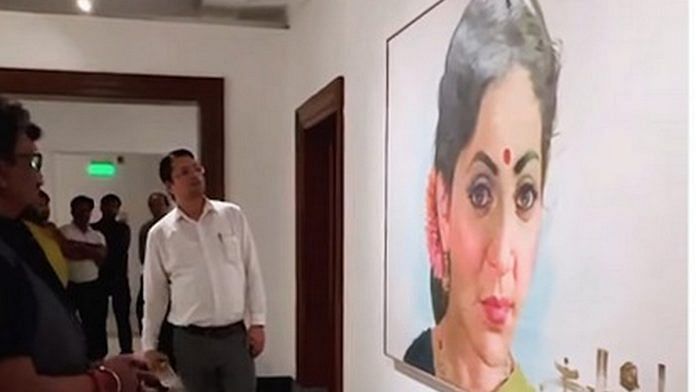New Delhi: With a red bindi and pink gajras in her hair, a larger-than-life Deepti Naval pins viewers with her knowing gaze. This time, though, she’s holding court on the first floor of the National Gallery of Modern Art, framed in a massive oil portrait.
Painted by the late Balkrishna Laxman Vaidya, the Chashme Buddoor and Katha actor has good company. Her portrait is one of six by Vaidya in ‘Celluloid Sojourn: The Women of Indian Cinema’, an exhibition of 46 artworks and photographs of women in showbiz—from gigantic watercolours to miniatures and black-and-white images capturing them working on set.
It’s as much a tribute to the painters and photographers who worked behind the scenes as it is to the women who created magic on and off screen in Indian cinema
The showstoppers are Vaidya’s bold paintings of Nargis, Meena Kumari, Madhubala, Nutan, and Naval. He was the man who created many of the towering, hand-painted billboards that once lured audiences in the Bombay of old. When digital printing took over and the craft became obsolete, Vaidya’s work found a second life in galleries across Europe and Australia, including an exhibition at London’s Victoria & Albert Museum.

The photographs in the NGMA exhibition are just as gripping—from Saroj Khan teaching dance on set to Smita Patil preparing for a shoot in Chhattisgarh.
“All of the people we selected were associated with (the work) behind the scenes, be it Dayanita Singh or Nemai Ghosh,” said curator Sushmit Sharma. “Ghosh travelled with Satyajit Ray during shoots, and captured the energy and artistic production behind the scenes. But most of all, it was also extremely fun to watch the movies, and pore over the photos while curating it.”
The exhibition was inaugurated on 1 April as part of NGMA’s 71st Foundation Day celebrations, and will be on display for a month.
Also Read: Ambedkar to Sai Baba—an exhibition blends art and academia to honour India’s saints
Maestros behind the scenes
Vaidya painted the stars people queued up to watch, but photographers Nemai Ghosh and Dayanita Singh were more interested in what happened when the cameras weren’t rolling.
Ghosh’s collection shows just how involved Satyajit Ray was in every aspect of a shoot—from sets and costumes to music, makeup, and choreography.
In one photo, he’s guiding a group of Santhal women through a dance sequence. Another has him supervising Sharmila Tagore’s makeup on the set of Company Limited (1971). In one frame, Babita is almost shoulder-deep in water during a shoot for Ashani Sanket, with Ray directing right next to her
Known as Ray’s photo-biographer, Ghosh documented the nitty-gritties of shoots long before BTS images of directors and actors became popular.
If Ghosh was watching the director, Dayanita Singh was watching the choreographer.
Her ‘Masterjee Series’ captures Saroj Khan in action—mid-pose, mid-correction—as she trains everyone from Madhuri Dixit, Twinkle Khanna, and Rekha to Sanjay Dutt and Ajay Devgn.

“Singh’s photographs reveal how Khan’s body becomes a language, her movements a rebellion. Her virtuosity spills beyond the edges of performance into pure, elemental expression,’ says the curatorial note.
Singh followed Khan while she coached Madhuri Dixit for Khalnayak (1993), the film that made her a nationwide sensation with Choli Ke Peeche. The series is a powerful insight into the life of Bollywood’s first female choreographer in what had previously been a male-dominated field. Her career spanned decades and countless songs.
“We have not listed the name of every movie because in some instances the dance sequence never made it to the final cut, or the movie never released,” said Sharma.
In documenting Khan in a space rarely occupied by women, Singh was also making strides in a field that was dominated by men. In 2022, she became the first South Asian to receive the prestigious Hasselblad Award, given to photographers recognised for “major achievements” in the field.
Also Read: JJ School of Arts is a museum in itself. Heritage walk explores its history
Matinee memories
The exhibition also offers visitors the chance to catch two films by Assamese filmmaker Rima Das, both of which are screened for visitors. Village Rockstars (2017) is shown daily at 2 pm, while Bulbul Can Sing (2018) is screened 4:20 pm from Tuesday to Sunday.
Village Rockstars was Das’s breakthrough. The coming-of-age film travelled to some of the most prominent film festivals across the world—from Spain’s Muestra de Cine Lanzarote to the Cairo International Film Festival—and was India’s official entry to the Oscars.
Also on the screening schedule is Meghe Dhaka Tara, Ritwik Ghatak’s 1960 classic about Partition in Bengal, shown at 11 am.
On a Wednesday afternoon, a handful of visitors took a pause in the screening room to watch a few scenes from Das’s Bulbul Can Sing. Outside, phones came out for quick snapshots with the stars.
Retired government employee Ramesh Singhal surreptitiously clicked one of Vaidya’s Meena Kumari portrait.
“My wife is still jealous that I find her prettier,” he said. “But it is very nostalgic. These massive hand-painted hoardings were part of my experience of watching movies back in my teens, when we saved up money to watch matinee shows.”
It summed up what NGMA wanted to do—remind people of the women in cinema they might have forgotten.
(Edited by Asavari Singh)






